I have already mentioned in the previous sequel that numerous houses may be seen in the old town of Rethimno that still exhibit elements of the Venetian architecture, such as stone doorways, as well as Ottoman elements, such as covered balconies. On some you can see both influences.
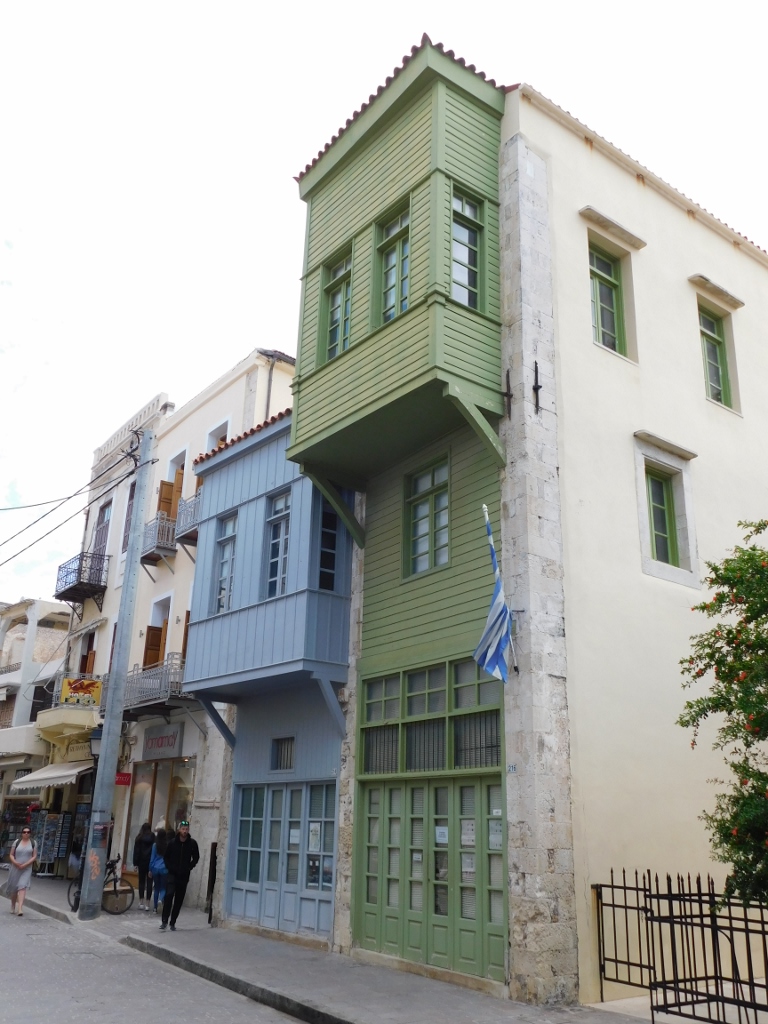 Rethimno, a detail
Rethimno, a detail
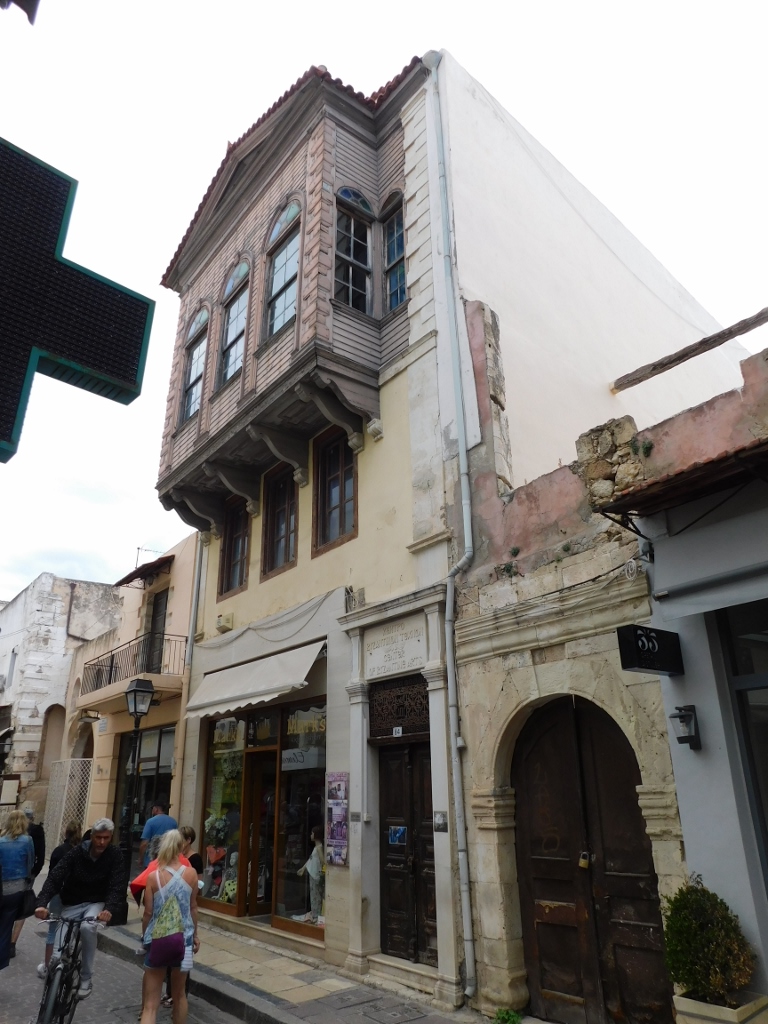 Rethimno, a detail
Rethimno, a detail
Of course, many sections of the old town that is very popular among visitors have numerous souvenir shops.
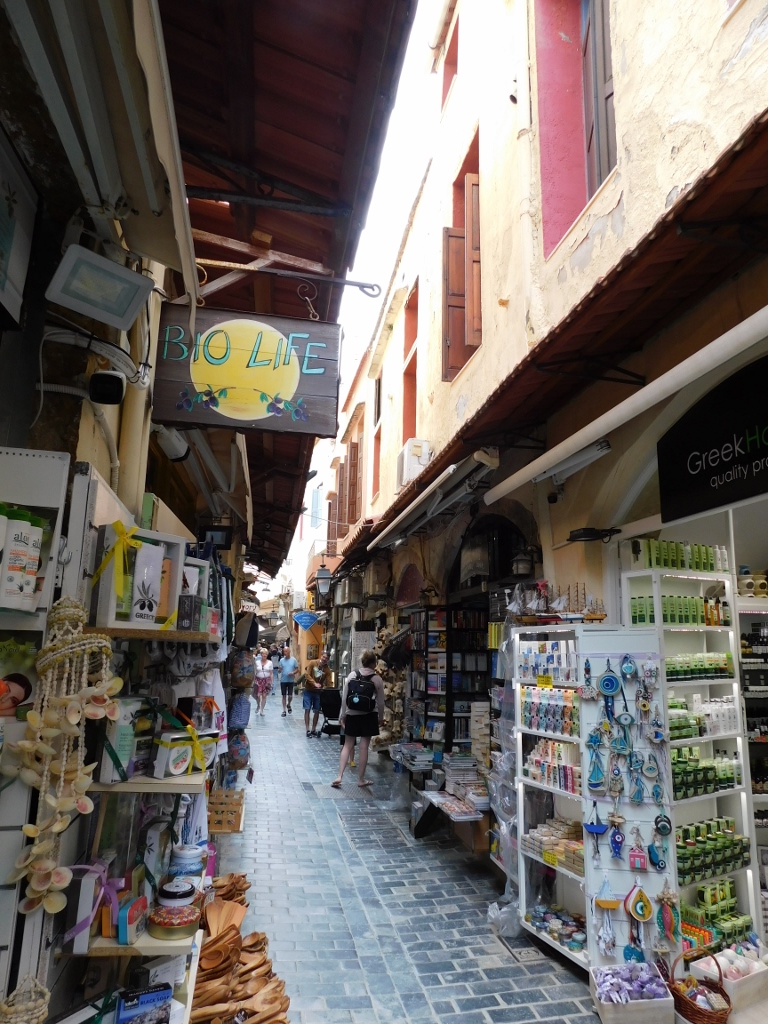 Rethimno, a detail
Rethimno, a detail
On my flight to Crete, I read the airline magazine that happened to have a text about Rethimno. Apart from the accounts concerning the history and culture of the town, there were also some recommendations about the restaurants and pastry shops.
So, now I decided to walk to a pastry shop that was located in the new part of Rethimno and first I left the area of the old town using Guora Gate (Porta Guora) from the second half of the 16th century. Back in the day, this was the main entrance into the town nested within the city walls built during the Venetian rule.
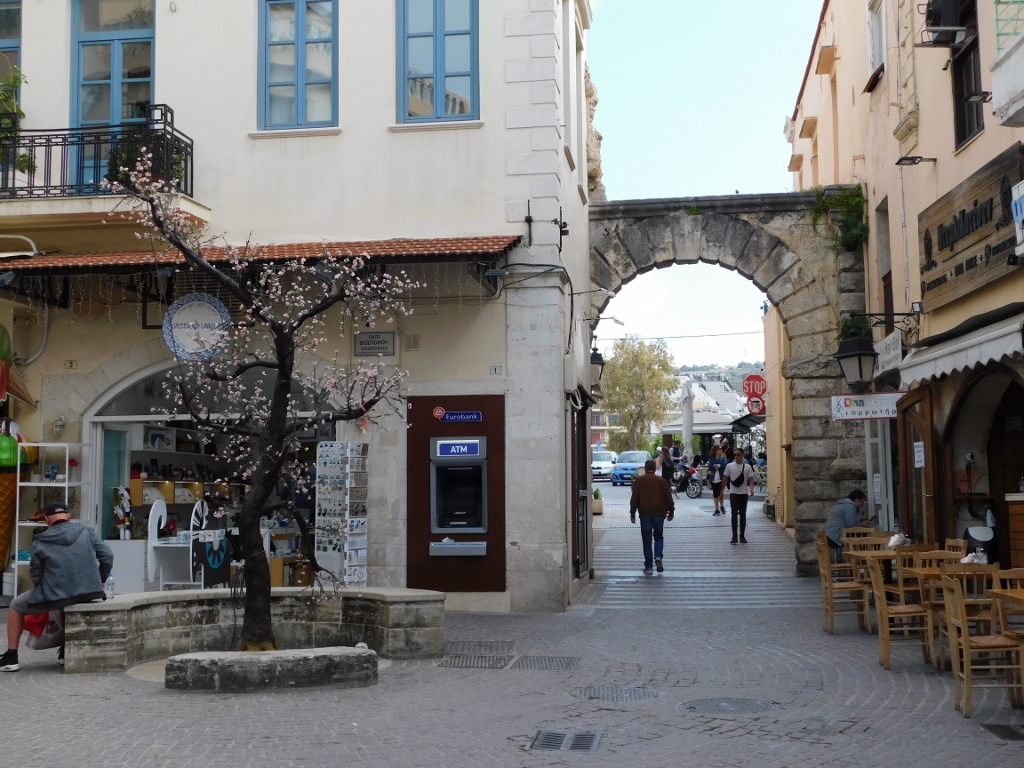 Guora Gate
Guora Gate
As a rule, I don’t advertise any hotels or restaurants I visit, so I will not do that with this pastry shop either. I can only say that the sweets were tasty and exceptionally skilfully made.
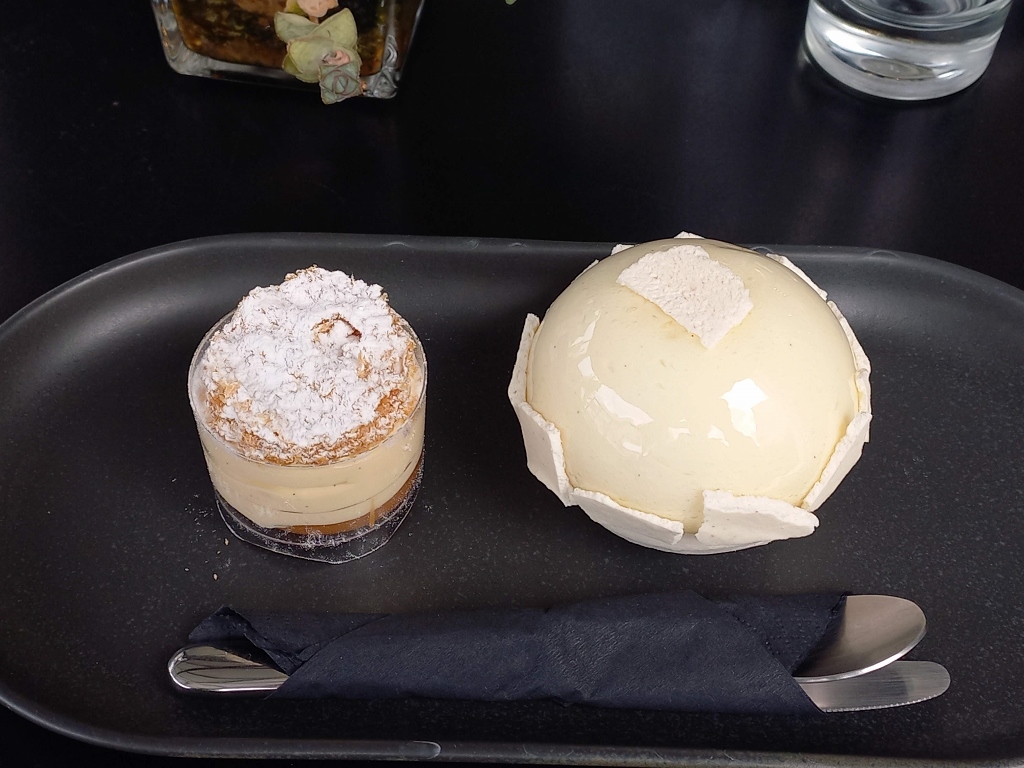 Sweets in Rethimno
Sweets in Rethimno
And yet, neither this break nor these sweets helped me feel better. I have already mentioned that upon my arrival in Rethimno I was overwhelmed by some strange fatigue. I had a brief respite at the hotel, but that did not help much. As it can be seen from the text, I did walk a great deal afterwards, simply by moving mechanically, but I lacked the lightness feeling tired all the time instead.
In such a state I continued with my sightseeing and so I returned to the old part of Rethimno, this time going directly from the pastry shop to the east sections of the old town. The streets there were just as pretty.
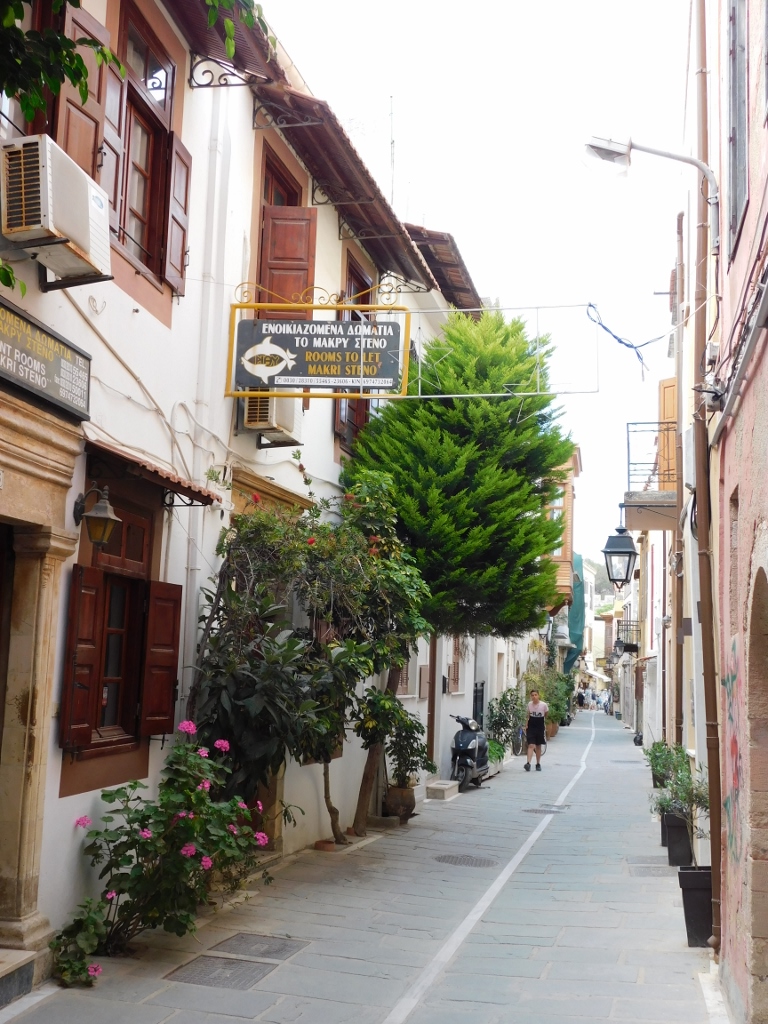 Rethimno, a detail
Rethimno, a detail
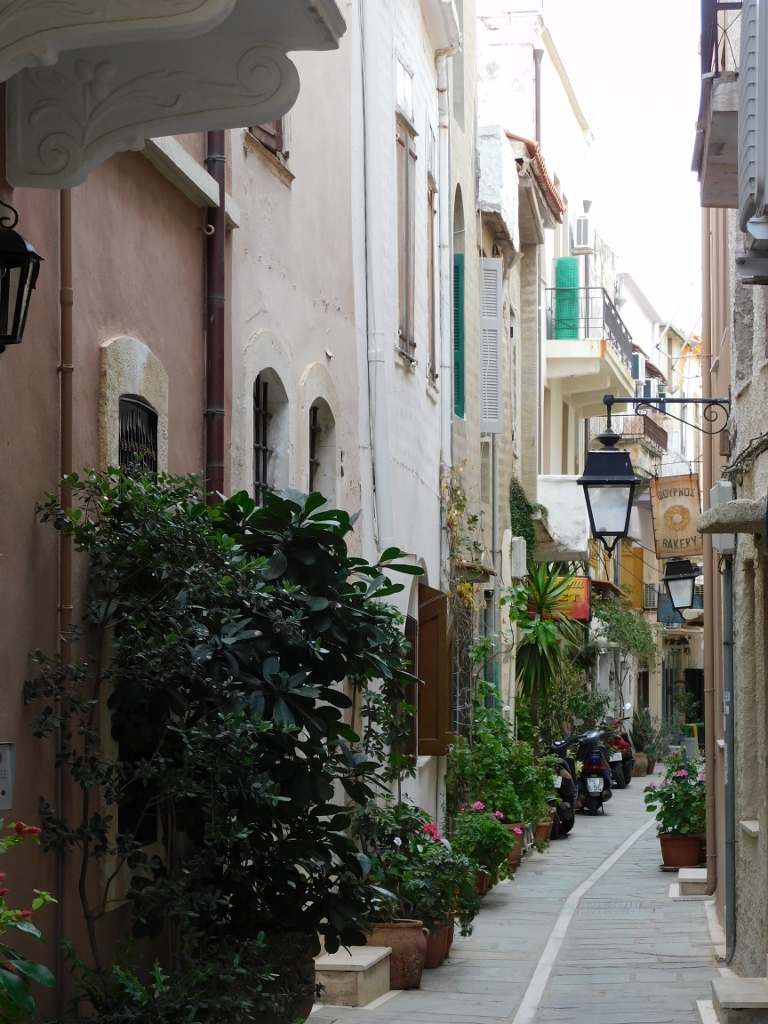 Rethimno, a detail
Rethimno, a detail
While walking along the narrow streets of the old part of Rethimno, I passed over a small, but very cute 25th March Square. There was less noise and no crowds coming from visitors in this part of the city, so I would have gladly sat down here if I hadn’t already had coffee with the sweets back in the pastry shop.
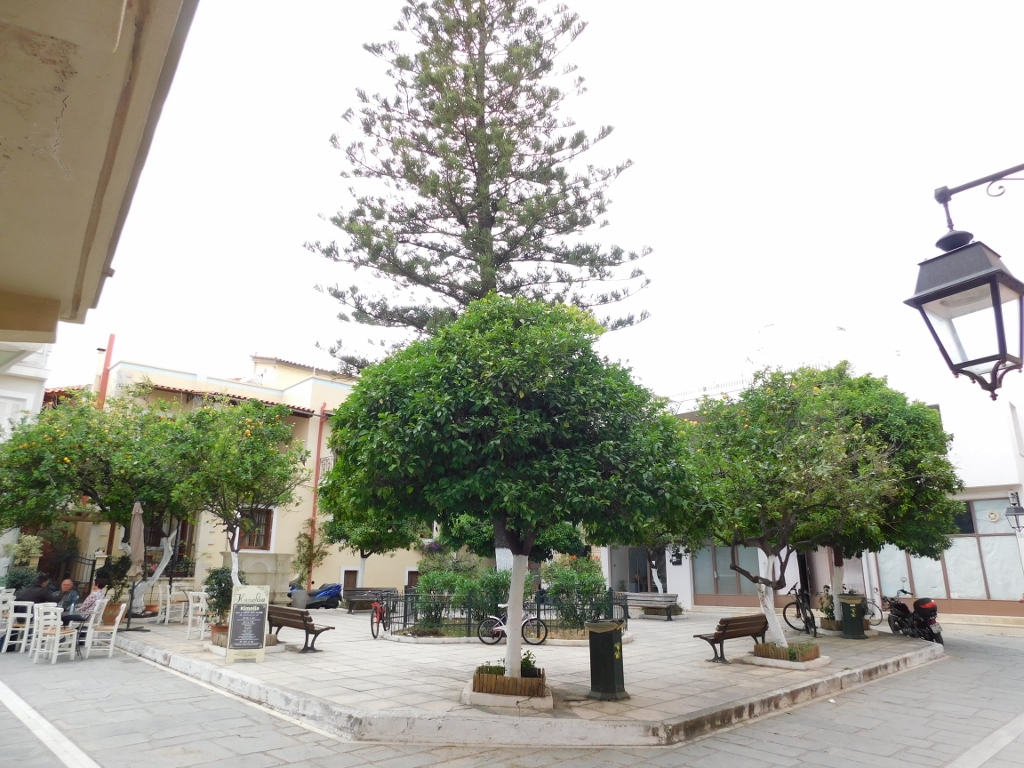 25th March Square
25th March Square
Some hundred metres farther, one comes to a larger square with the Metropolitan Cathedral dedicated to the Presentation of the Virgin Mary.
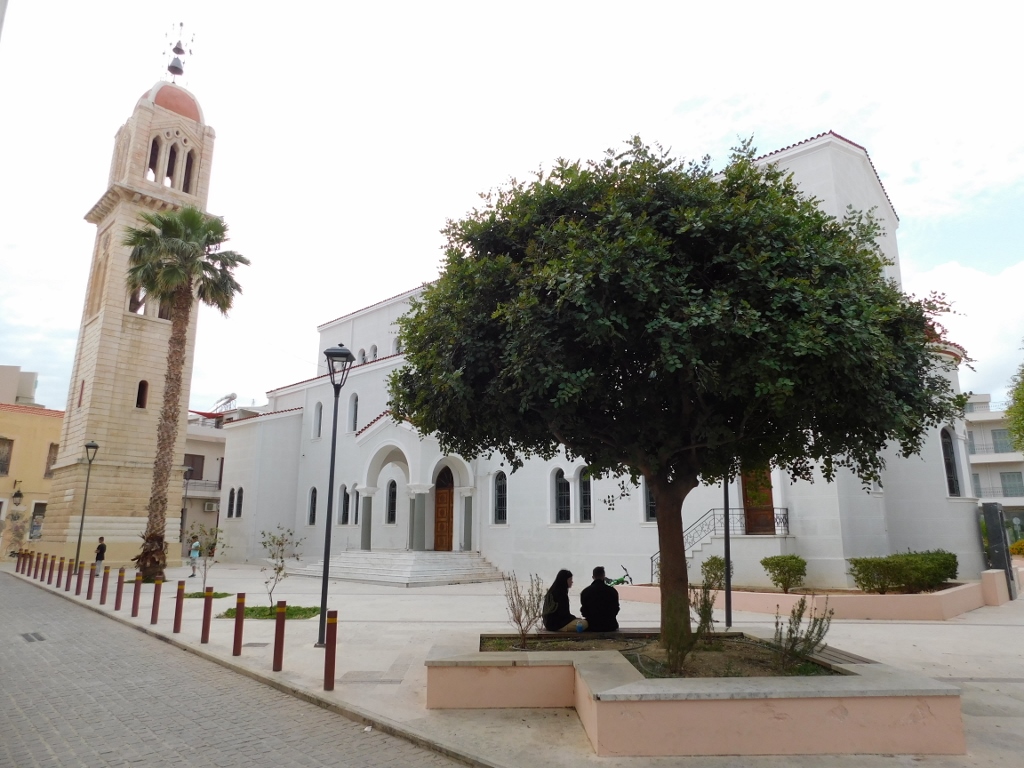 Metropolitan Cathedral
Metropolitan Cathedral
The cathedral was built around the middle of the 19th century, but was damaged in WWII and had to be demolished. The church seen today was built in the same spot. On the other hand, the interior follows the form of the original church and there is also the iconostasis from 1852.
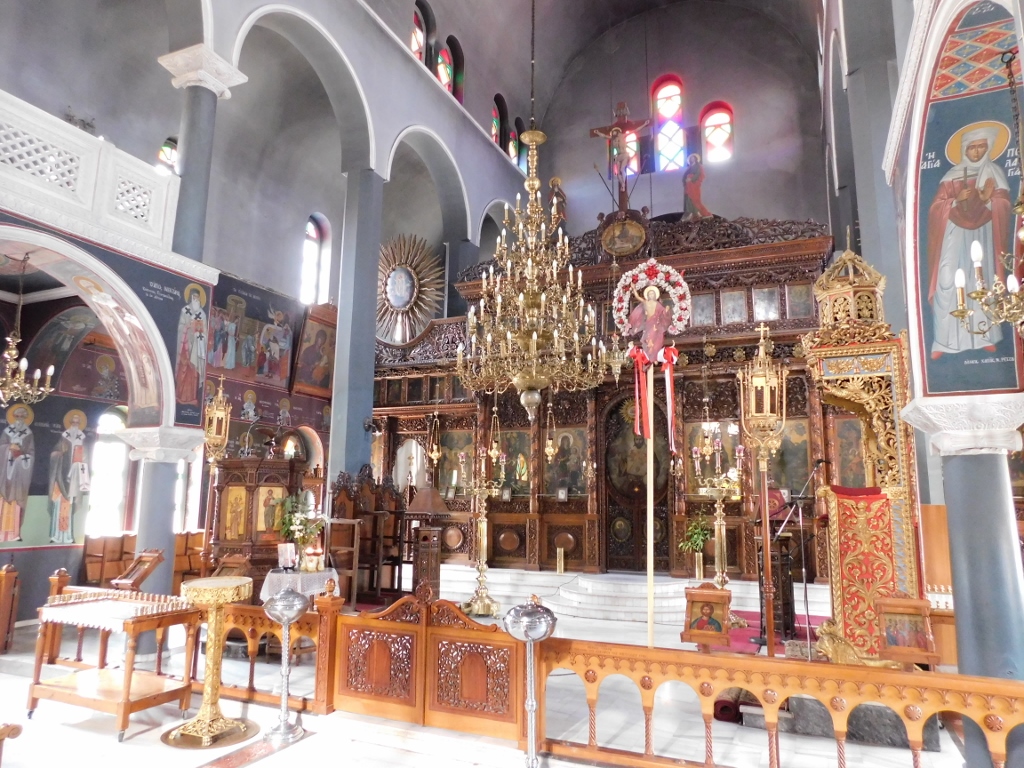 Metropolitan Cathedral, the interior
Metropolitan Cathedral, the interior
Another hundred metres or so farther, I came across yet another church, but significantly smaller one. This is the Church of St. Barbara that was built in 1885 in the place of an earlier church from the 17th century.
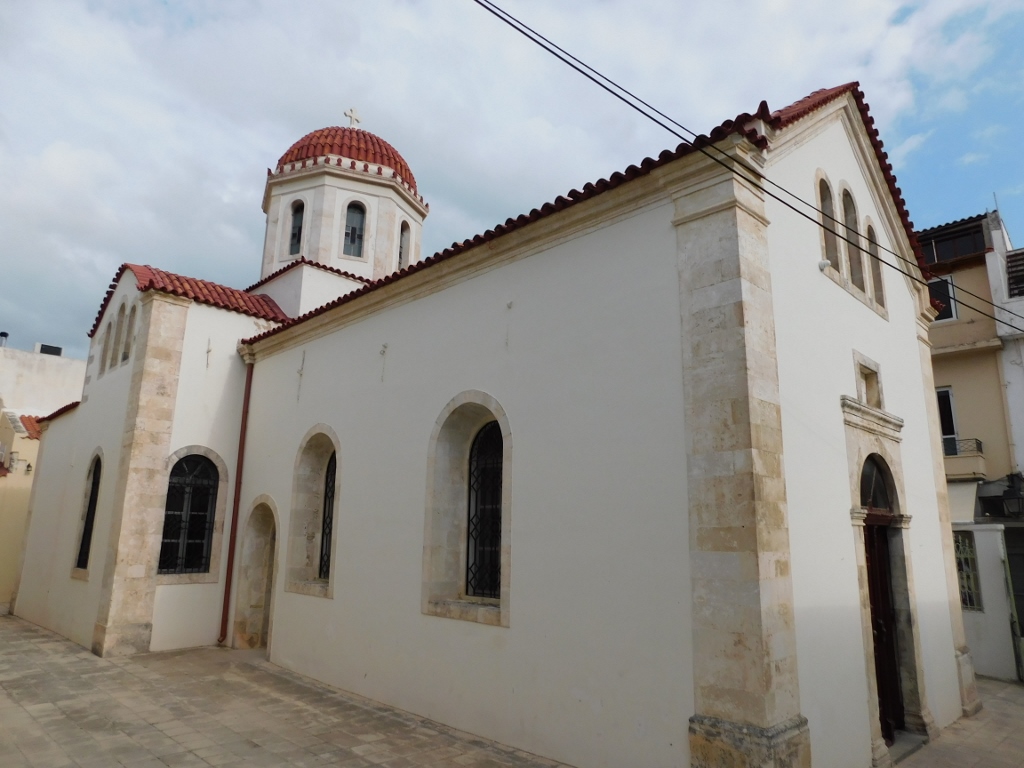 Church of St. Barbara
Church of St. Barbara
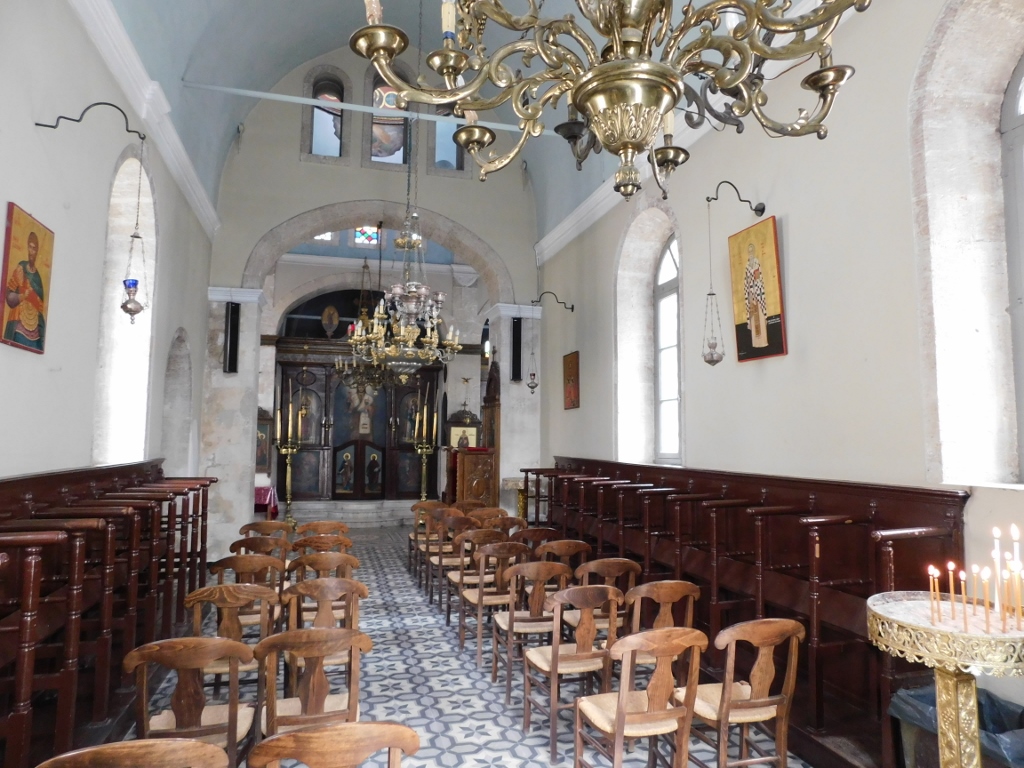 Church of St. Barbara, the interior
Church of St. Barbara, the interior
Although I was not particularly hungry, I took the advantage of the nearby position of a restaurant for which I had received recommendations and I was especially drawn to the following dish – octopus mousaka with aubergine béchamel. I love simple food, but every now and then I like to try some contemporary culinary experiments. It was tasty.
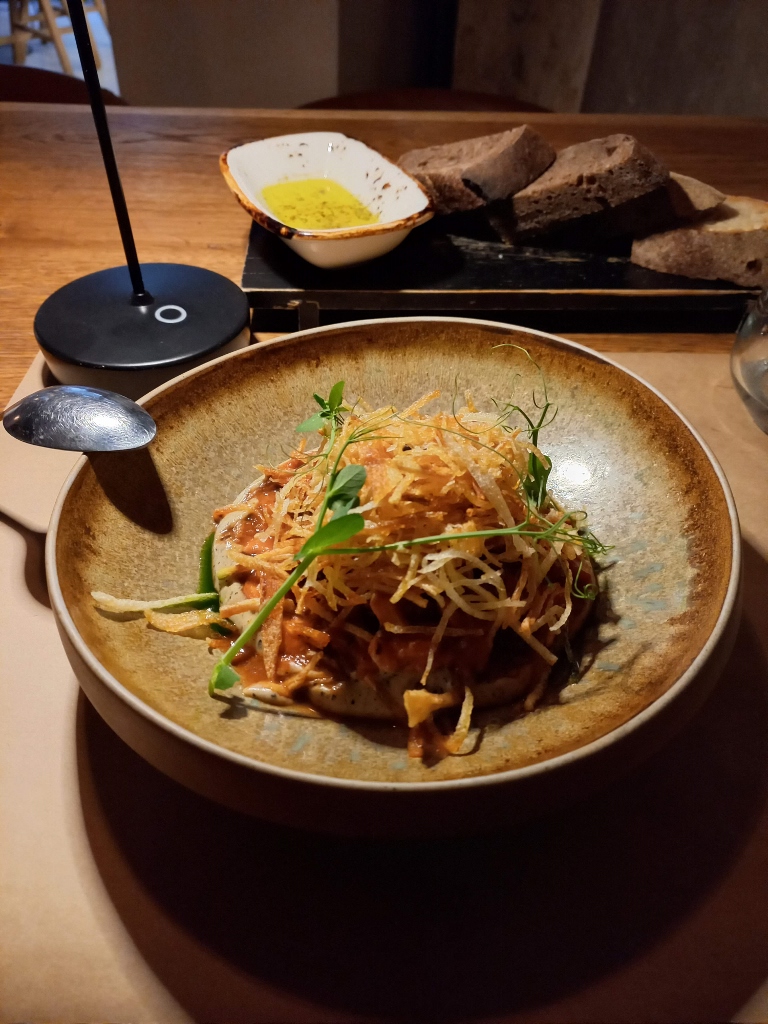 Early dinner in Rethimno
Early dinner in Rethimno
But, even the fine food could not bring any lightness into my existence, so after the meal I slowly walked back to my hotel. In line with this, I went to bed quite early, but I also woke up quite early the next morning.
I felt significantly better and I also had very specific plans on this day. Namely, the plan was to head for the south of Crete and in the meantime I had realised that the best thing for me would be to rent a car, practically until the end of my stay on Crete. As soon as I arrived in Rethimno I asked the hotel for recommendation and we had already considered the day before what they could help arrange for me. It was quite expensive, though, and so I searched on internet where I could rent a car myself. I did find something and I booked it, but I realised that I would be able to pick up the car at the office of that rent-a-car company beside the long beach in Rethimno only later.
Since I had most of my morning free, I went for a walk and some more sightseeing. Thus I passed by a place where there must have been an Ottoman fountain and then I turned a little to the left, a little to the right, eventually reaching a street that went a little uphill towards a fortress from the 16th century.
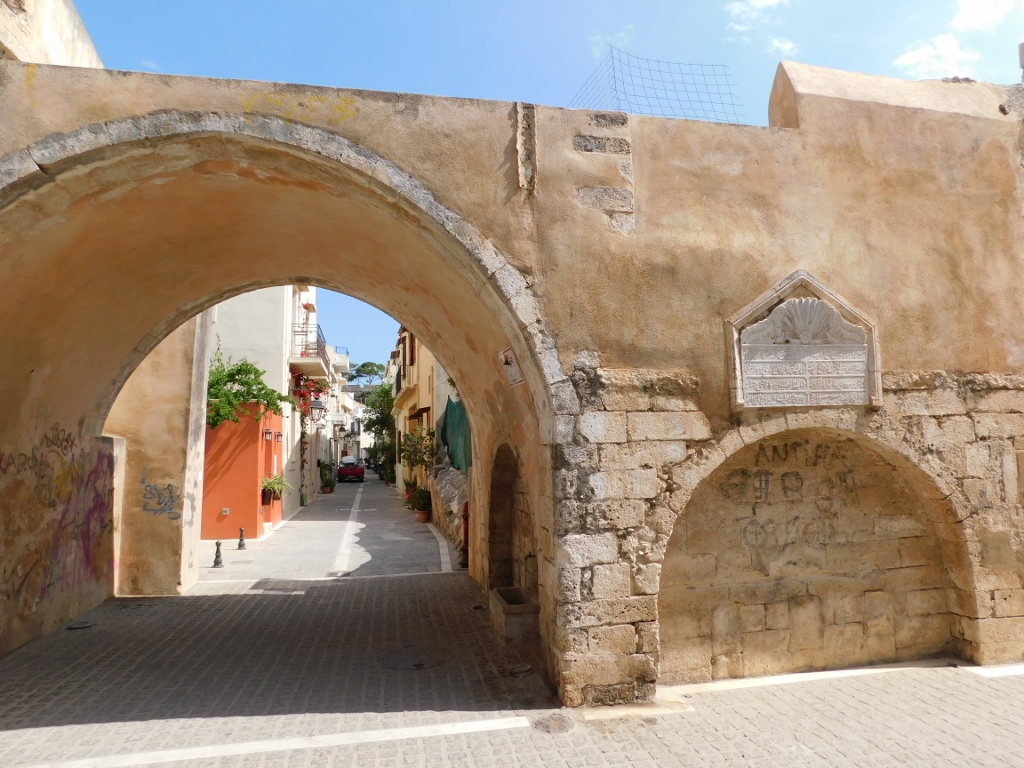 Rethimno, a detail
Rethimno, a detail
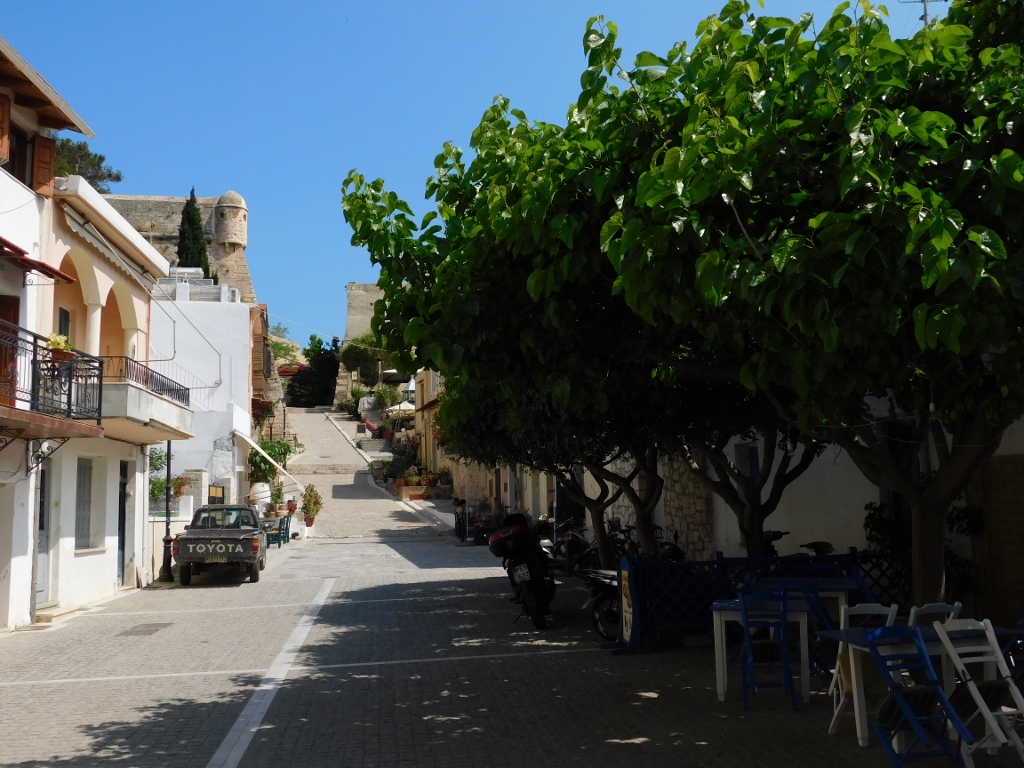 Rethimno, a detail
Rethimno, a detail
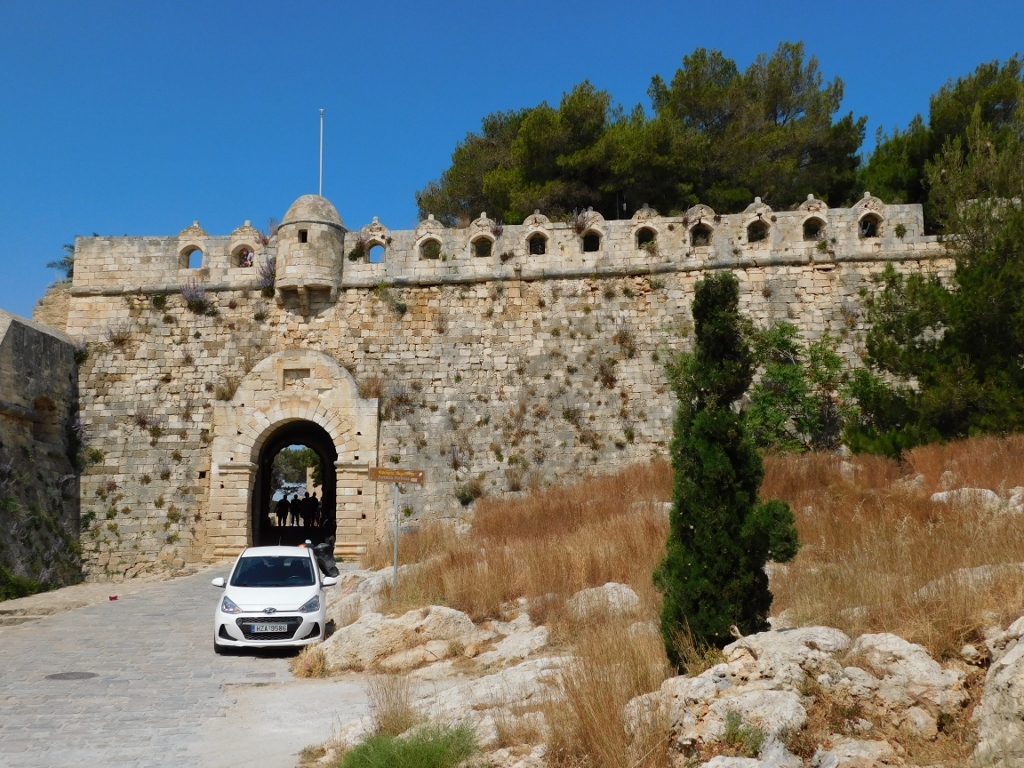 Entrance into the fortress
Entrance into the fortress
While I was taking a photo of the entrance into the fortress, I could hear a very nice melody played on a saxophone by a guy, but I did not hang around at all, since my time was limited.
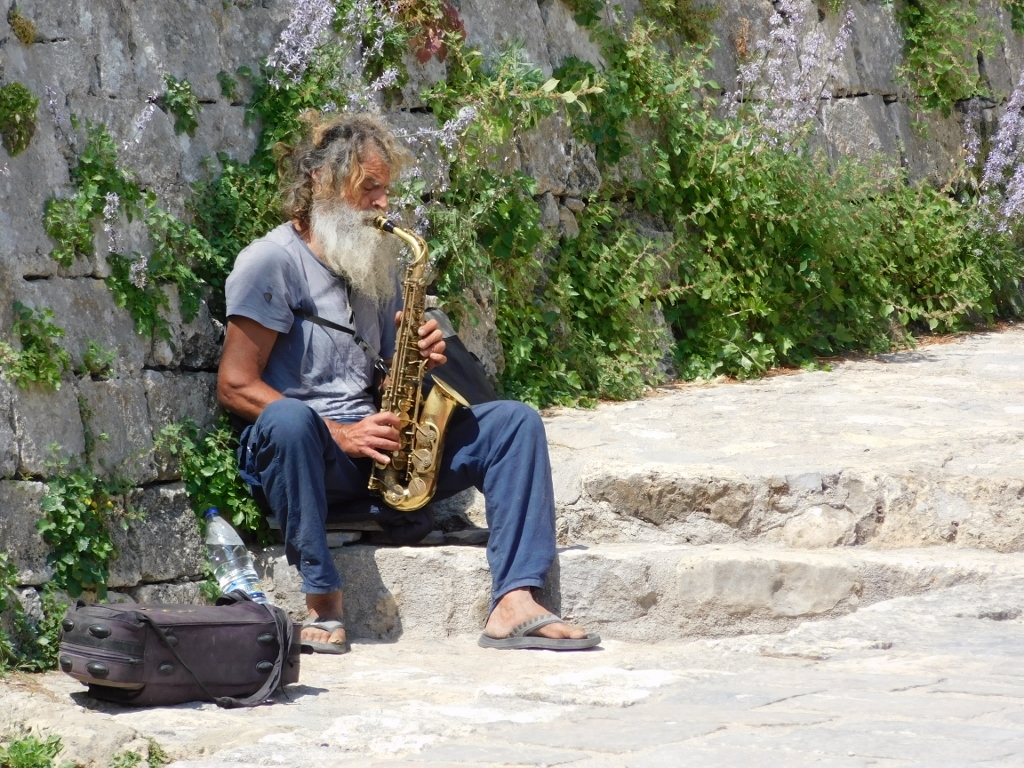 Rethimno, a detail
Rethimno, a detail
I bought a ticket, entered the fortress complex, but I first climbed the ramparts from where I had a beautiful view at the west sections of Rethimno.
 View from the fortress in Rethimno
View from the fortress in Rethimno
As for the fortress itself, or rather the citadel, it has an irregular star shape and the beginning of its construction on a promontory with a hillock in Rethimno is linked to the year 1573. The fortress is often called by its Italian name – Fortezza. Apparently, this was the biggest fortress the Venetians have ever built and it could hold the entire population of the city. For this reason, there were also a cathedral and a hospital built within it, as well as various military buildings. Around the middle of the 17th century, the fortress was taken over from the Venetians by the Ottomans. Today, the visitor can see several interesting structures within the walls and this is certainly a very good spot to come to if one wants to enjoy both the views within the fortress and those at different sections of the city.
 View within the fortress in Rethimno
View within the fortress in Rethimno
At the very beginning of the visit, I spotted from a distance a large domed building that used to serve as a mosque and there is a small church beside it. Still, I decided to get there a little later and for now I walked around the west part of the fortress where you can mostly see the ramparts and bastions.
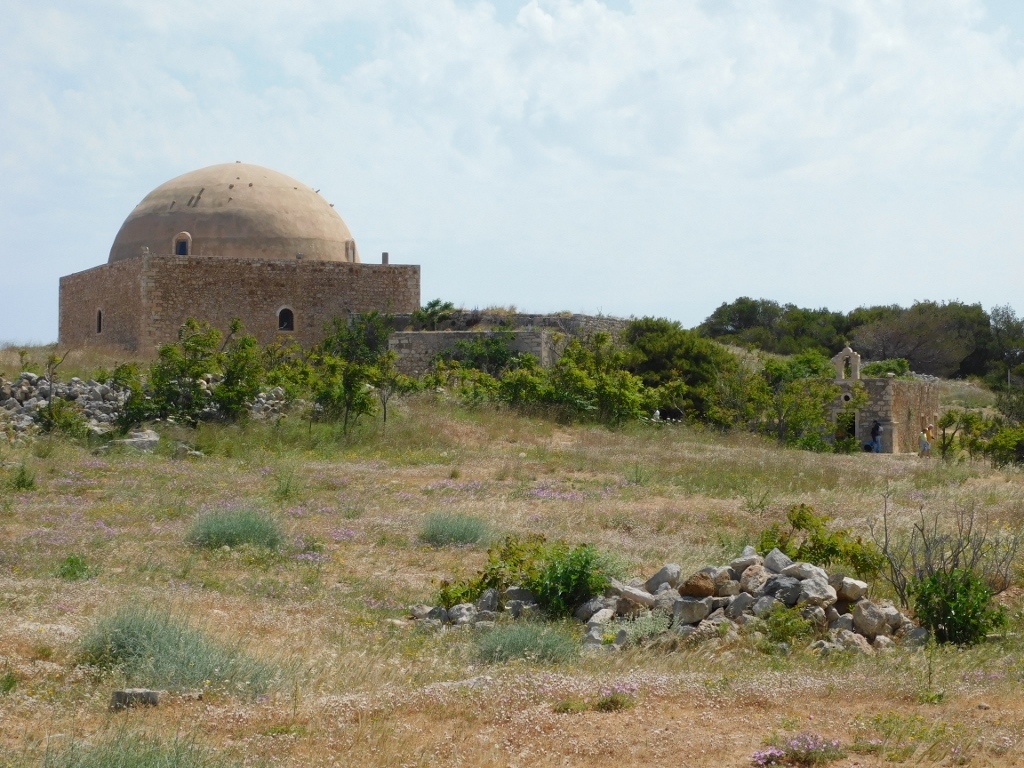 Some of the structures within the fortress in Rethimno
Some of the structures within the fortress in Rethimno
 West part of the fortress in Rethimno
West part of the fortress in Rethimno
In the north section there are several structures and a couple of them were used as gunpowder warehouses. Still, one building stands out in particular and this one used to be the Counsellors’ Residence. This was the place where one of the two Venetian city Counsellors used to live, while during the Ottoman rule this was the residence of one of their officials.
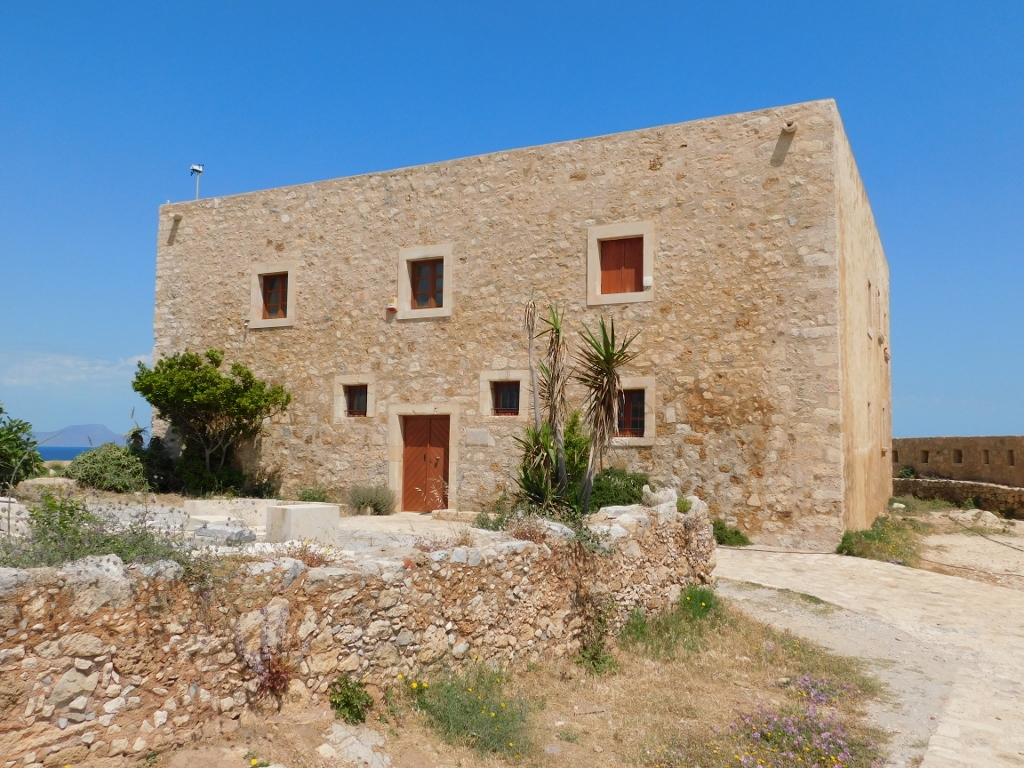 Counsellors’ Residence
Counsellors’ Residence
By the way, the internet and guidebooks provide different data, but what I’ve used here are the data I found in the brochure that I received when I bought the ticket.
In the direct proximity of the Counsellors’ Residence there is the Warehouse Complex near the Northern Auxiliary Gate where there were the main warehouses for the storing of food and water within the fortress.
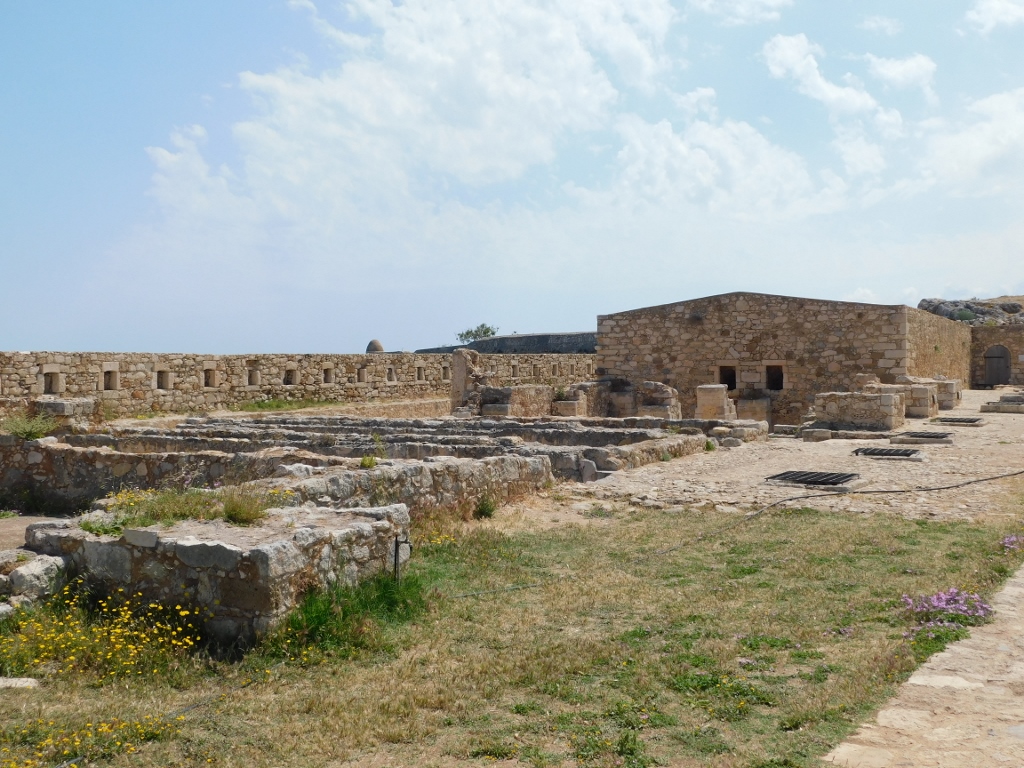 Warehouse complex near the northern auxiliary gate
Warehouse complex near the northern auxiliary gate
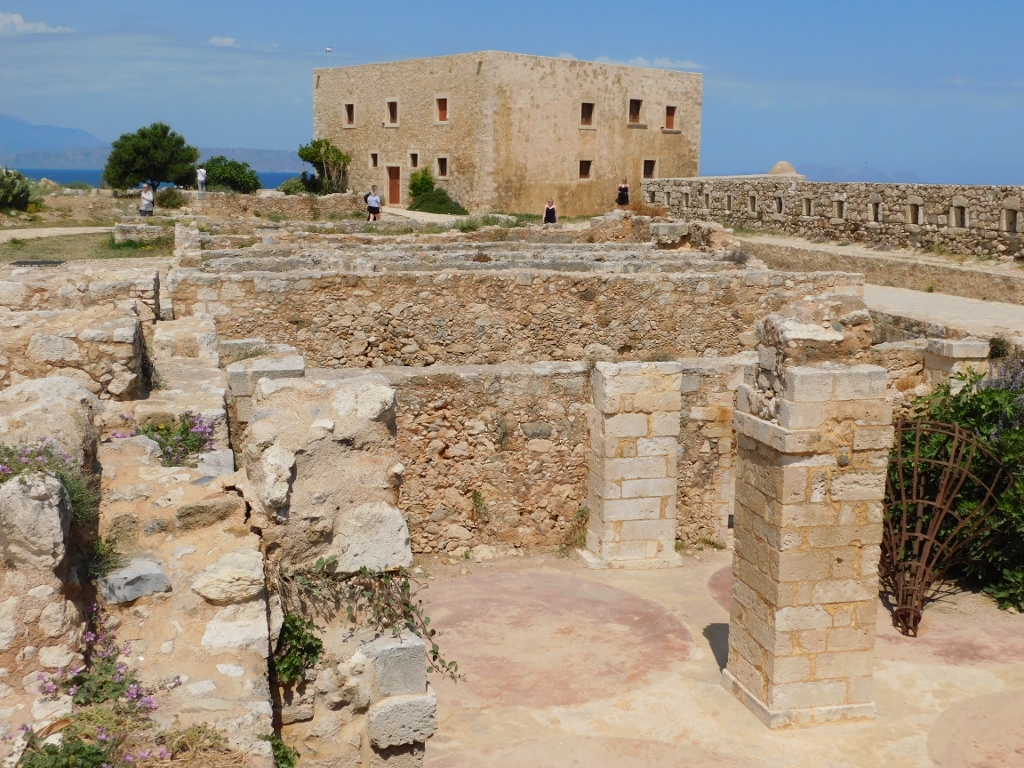 Warehouse complex near the northern auxiliary gate and the Counsellors’ Residence
Warehouse complex near the northern auxiliary gate and the Counsellors’ Residence
And now I went to the central part of the citadel where there is the Sultan Ibrahim Khan Mosque.
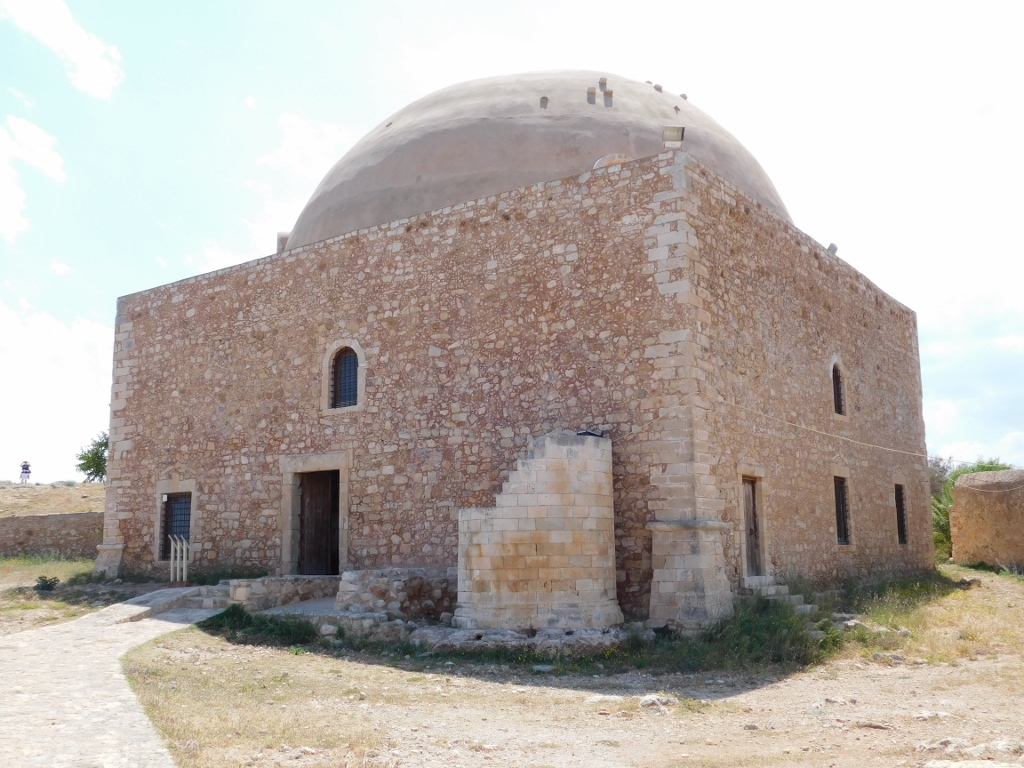 Sultan Ibrahim Khan Mosque
Sultan Ibrahim Khan Mosque
Originally, there used to be St. Nicholas Cathedral here, but the Ottomans demolished it and built a mosque instead. When you enter, you can see a very nice mihrab, the niche pointing to Mecca.
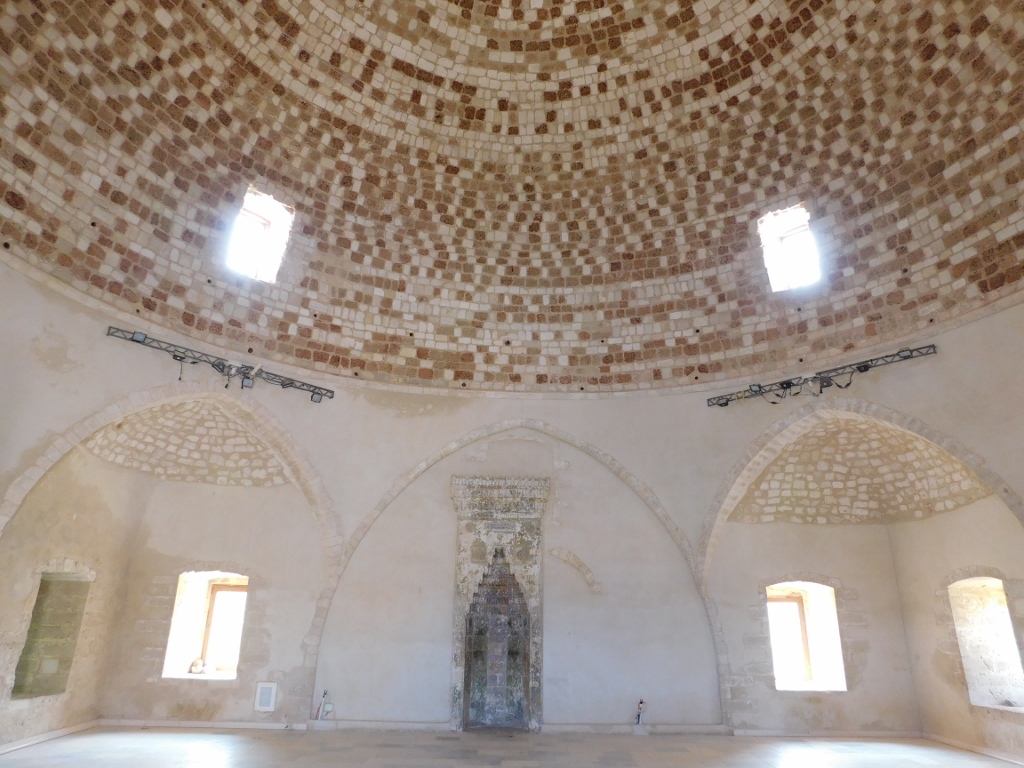 Sultan Ibrahim Khan Mosque, the interior
Sultan Ibrahim Khan Mosque, the interior
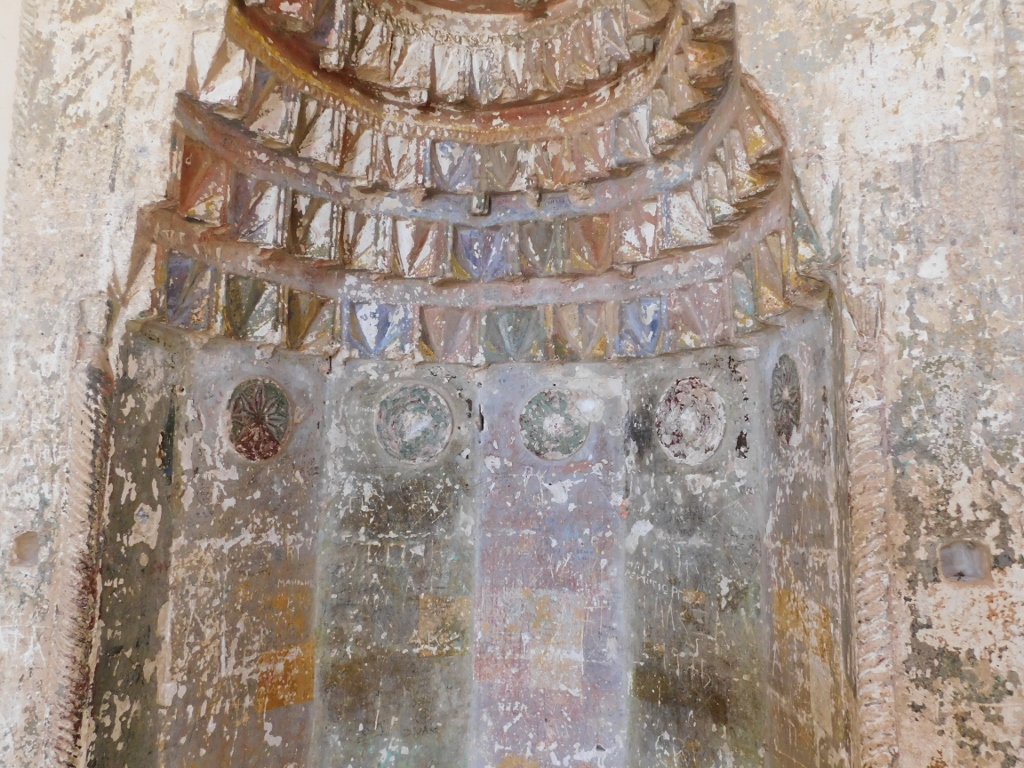 Sultan Ibrahim Khan Mosque, a detail
Sultan Ibrahim Khan Mosque, a detail
In the close proximity of the former mosque, there is St. Catherine’s Church. This used to be a water cistern, but in the 19th century it was turned into a church.
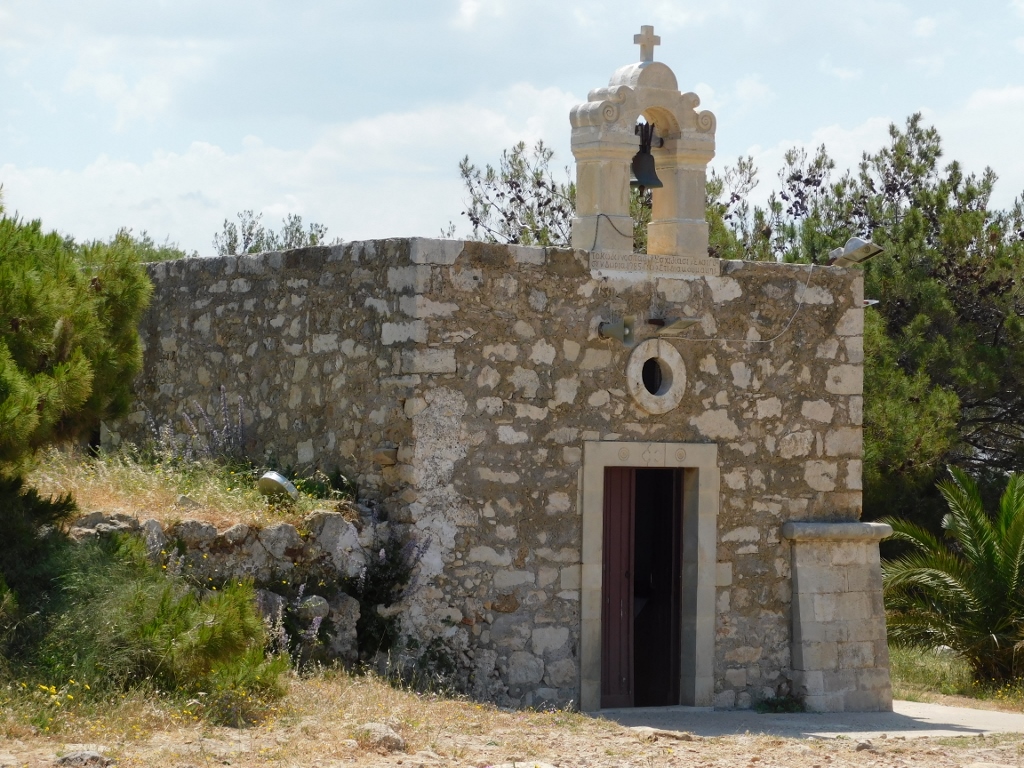 Church of St. Catherine
Church of St. Catherine
Now I moved to the east part of the citadel that was, to start with, significantly greener. There I came across yet another church. This is the Chapel of St. Theodore Trichinas consecrated in 1899, but this was probably just a restored older church from the Venetian period.
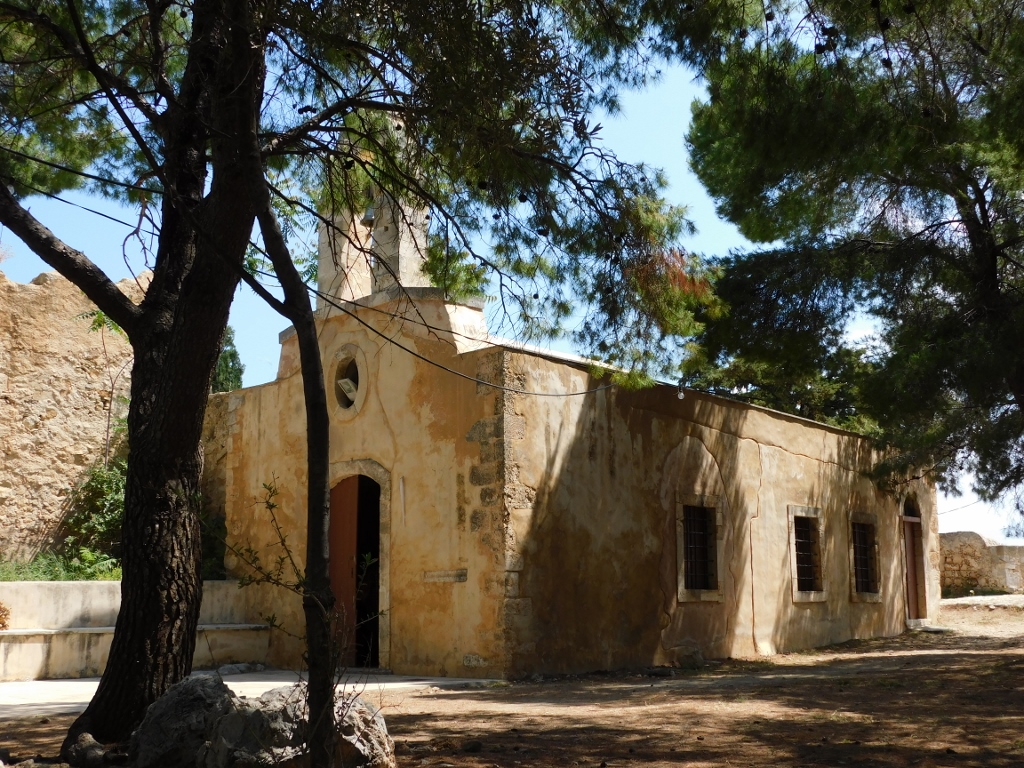 Chapel of St. Theodore Trichinas
Chapel of St. Theodore Trichinas
Very close to it there is the Twin Building named like that on account of the two segments covered by barrel vaults. It was built at the end of the 16th and the beginning of the 17th century, and is nowadays used as exhibition hall.
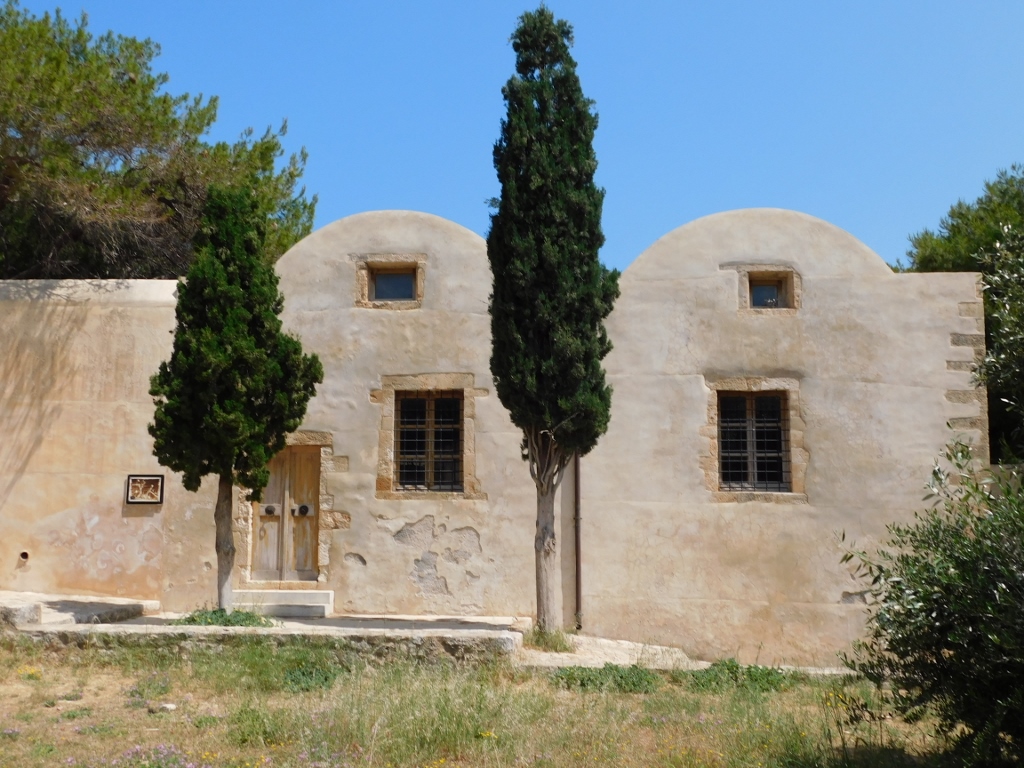 Twin Building
Twin Building
I walked here a little bit more near St. Nicolas Bastion and then I headed back to the exit.
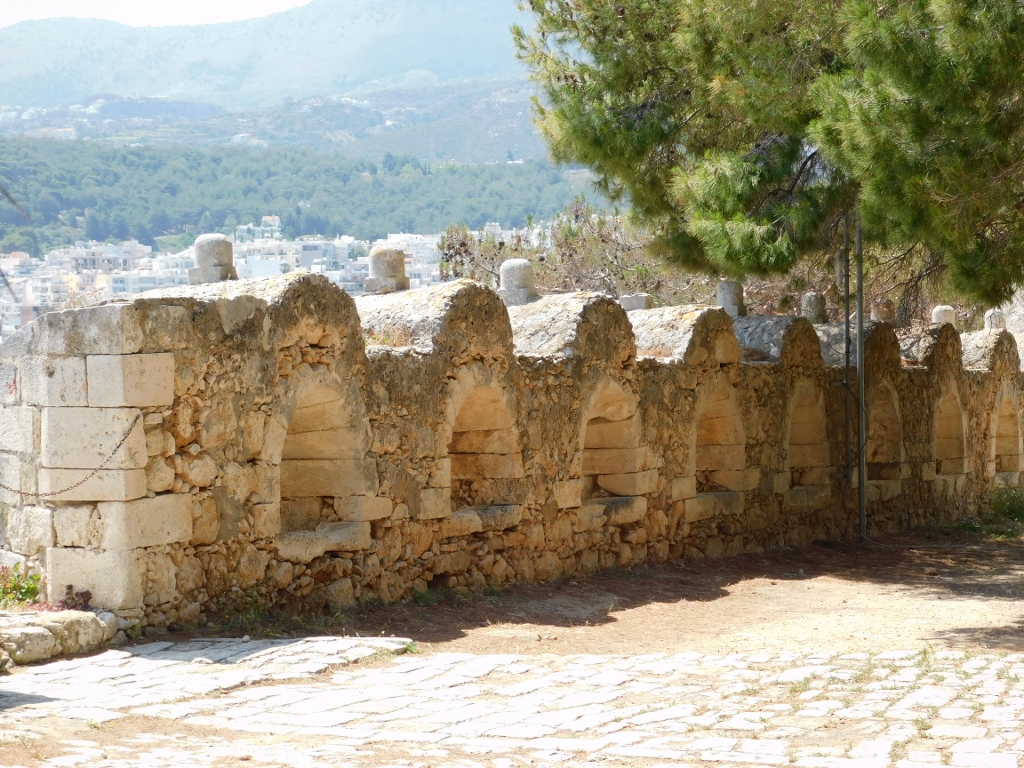 Part of the east ramparts of the fortress in Rethimno
Part of the east ramparts of the fortress in Rethimno
Now I had to deal with concrete steps linked to the departure from the hotel and taking over of the rented car, but I could not resist at one moment and had to take one more photo of the numerous picturesque streets that are so abundant in Rethimno.
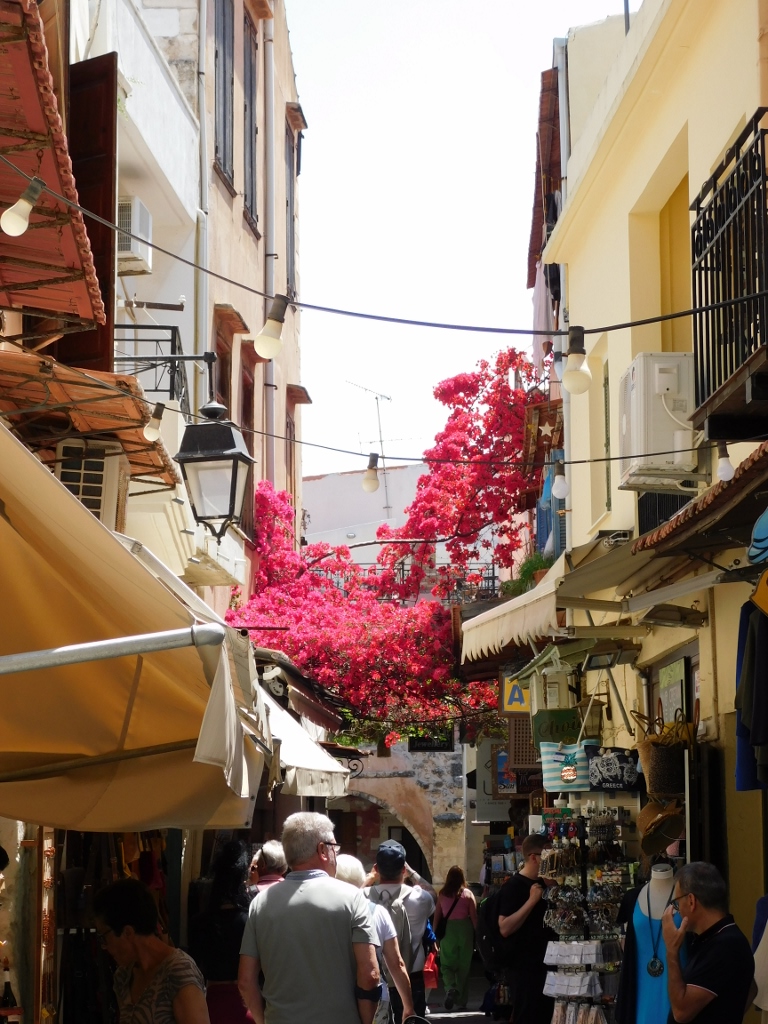 Rethimno, a detail
Rethimno, a detail
So, I first went to the hotel, left the room, but I also left my luggage at the reception. Then I walked to the rent-a-car agency, took over the car and then returned by the car close to the hotel where, with a lot of luck, I found a parking place. I went back to the hotel again, took my things and returned to the car. I was quite ready for the continuation of my journey.
Since I actually did not plan originally to rent a car on Crete and move around the island in this way, I was not quite prepared (although, fortunately, I did have my driving licence with me). But, I was also very lucky that the owner of the hotel at which I stayed in Rethimno was an exceptionally kind man who gave me a few recommendations. Some of them turned out to be spectacular, but more about this later on.
For now, I headed for the south parts of the island, but I needed a little time to get used to the GPS device. I had an impression it took me a little more to the east than planned/desired, but as it turned out this was exactly where I was supposed to go.
And so, at one point when I was leaving a very sharp curve driving more slowly, I noticed a brown board by the road pointing to the left and I could only read “Ancient (something).” I decided on the spot to make a turn there. I thought there was no reason to skip something “ancient” on Crete.
As it would turn out, the board showed the direction leading to Ancient Eleutherna or more accurately to the remains of an ancient town-state that existed here from around 1000 BCE until the Byzantine rule over the island. And yet, I did not go there.
Namely, some hundred meters from that turn I got to a spacious parking lot and realised something was “going on” there, so I simply parked and got out of the car.
First I went to a couple of information boards for visitors and there I realised there was a trail leading to the archaeological site of Ancient Eleutherna from there, as well as a hamlet that is famous for its pottery. This was certainly most tempting, but my plans for the day simply left no space for any hiking. Still, it is worth knowing this.
Then I started to look around and first I noted a building that would turn out to be the Ossuary of the Victims of 1866.
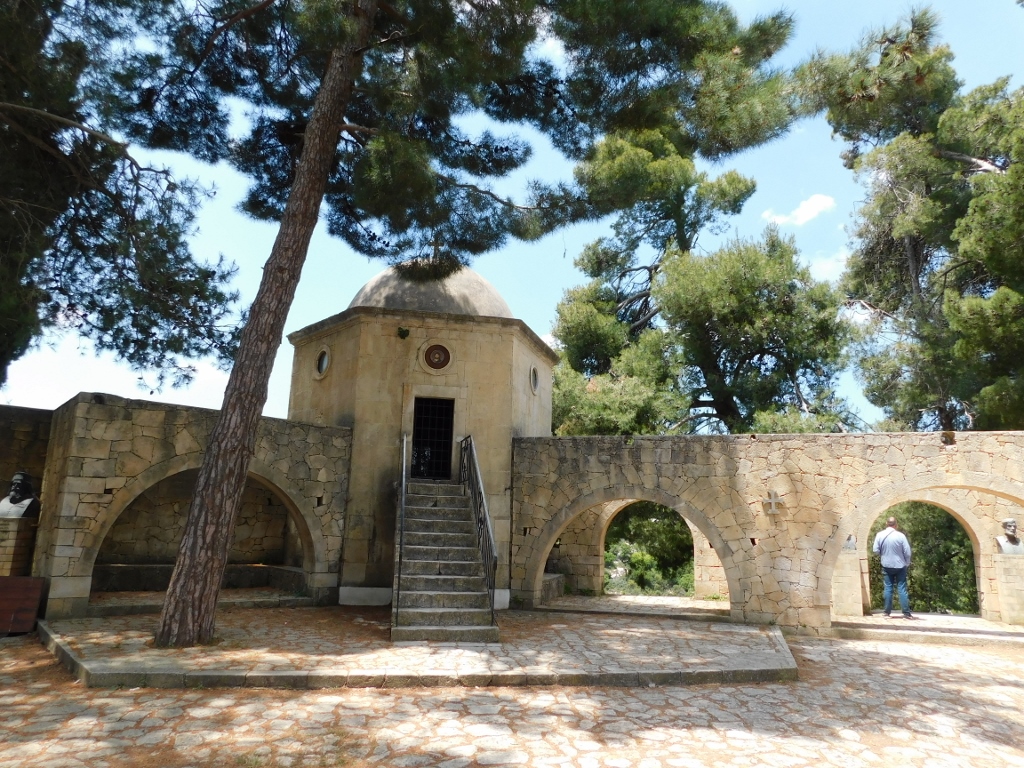 Ossuary of the Victims of 1866
Ossuary of the Victims of 1866
Namely, an uprising against the Ottomans on Crete started in August 1866 (it lasted until 1869). Already on 8 November 1866, numerous Ottoman forces (around 15,000 of them) came to the central parts of Crete and Arkadi Monastery where the headquarters of the uprising was and where numerous women and children also withdrew (around 700 of them). The Ottomans offered to the rebels to surrender, but this was declined. A battle and the mutual exchange of fire ensued. There were several rebels at the monastery’s windmill, which is the building with the ossuary today, but the Ottomans set the building on fire thus killing the rebels. Most of the rebels that were within the monastery’s walls were relatively well protected there, while the Ottomans had a lot of losses. The battle lasted until the evening and it continued towards the evening of 9 November when the assailants got a couple of particularly powerful cannons from Rethimno. Thus the monastery’s door was demolished and the Ottomans entered the monastery, although suffering significant losses in the process. On the other side, the rebels were getting short on ammunition.
The women and children were hiding at the gunpowder magazine, while the Crete fighters were slowly losing ground. One group withdrew to the dining room area where the Ottomans massacred them, while another group under the command of one of the leaders of the uprising gathered at the gunpowder magazine. When the Ottomans reached the door of the magazine, the rebels (some sources say the leader of the uprising, some other claim the hegumen of the monastery) blew up the gunpowder thus preventing the Ottomans to catch them alive. At the same time, a large number of assailants were also killed. It is estimated that around 1500 Ottoman soldiers were killed here, while there were 259 defenders.
I could not help but remember the same type of death chosen by Serbian Vojvoda Stevan Sinđelić, also within the scope of an uprising against the Ottomans, which I have already written about (See: https://www.svudapodji.com/en/serbia-2006-2/). It is more than obvious that the rebels throughout the Balkans preferred to blow themselves up (including also women and children) than to be captured by the Ottomans. I guess one can presume why.
But, now I have to emphasise, that I knew none of this before May 2022 when practically by chance I turned here from the main road I was driving along. My guidebook did mention Arkadi Monastery, but as I did not plan to visit Crete by car, I did not include this monastery in my plans, so I actually did not even know at first where I came.
I guess this was one of those God’s plans that bring us to a certain place.